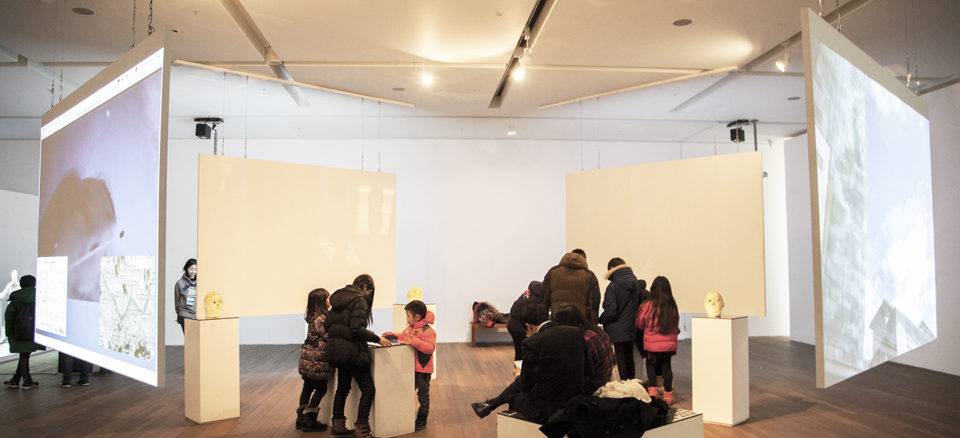
Introduction
Computer games have become an integral part of our everyday culture. The game industry is now the branch of the culture industry with the highest turnover. Artists from a wide variety of disciplines are contributing to the creation of ever more complex digital worlds. It is conceivable that by focusing on social, economic and aesthetic issues connected with computer games that games can emerge as a new form of art, possessing strong artistic content.
For example, the exhibition “Art of Games”, was held in Seoul to highlight the next generation of game design with apps for tablets from an international body of game designers. The setup of the exhibition went beyond the common goals of showcasing games, because the games were not only presented in a coherent manner for all to enjoy, but they were offered to the public embeded in a distinctive ambient scenography.
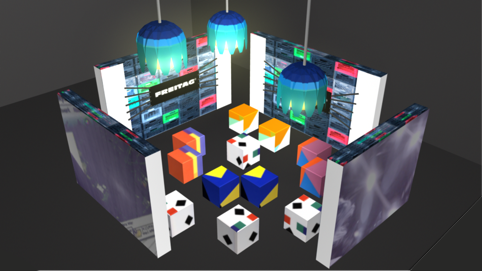
Image 1. Original “FREITAG Pop Up Gaming Space” model taken from the project proposal from the Swiss arts group, the Curious Minded. Entire construction made of tarps, cables and beverage crates.
By having access to a variety of games, visitors were offered offer a peek into the concept of art games, which ushers in an alternative to award based games by introducing the concept of using them for creative exploration and group interaction or collaborative play that is limited in scope and provides structures that use closure. Perhaps never to be as popular as games that explore violence, they do offer an alternative.
Rather than offering a game type arcade space, the space in which the games were offered was designed as a space to nurture play and provided visitors with a unique space to enjoy this new genre of art while feeling allowed to simply engage in emotional play, engaging themselves from simple electronic game playing to physically interacting with the space alone or in team with others, know or unknown to them.
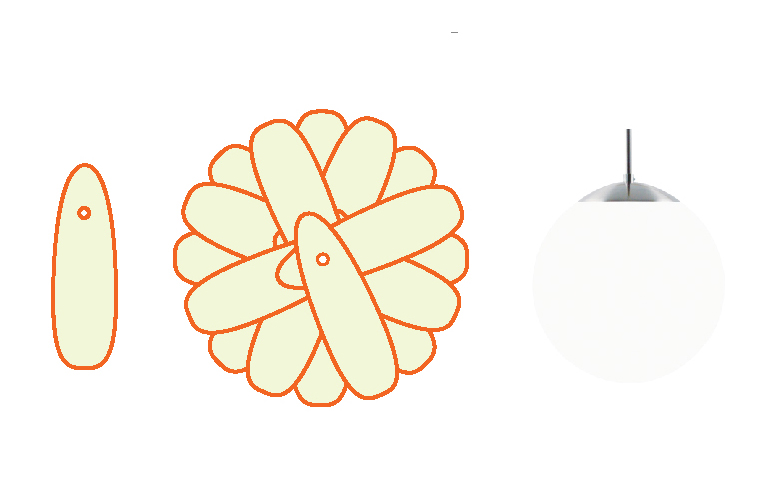
Image 2. Construction Details of Curious Minded’s Urban Lamp Cover made of layered tarp pieces and designed for the Pop Up Space.
The discussion whether gaming is an art form or not is with this exhibition superfluous, because though it, all can experience on hand that the game industry is now part of the culture industry and because of the complexity of digital scenarios, the focus of a game varies and can include educational, social, and economic issues, as well as artistic endeavours

Image 3. Hybrid solution for the Pop Up Gaming Space by Canadian art collective, Noxious Sector and Swiss arts group, The Curious Minded.
Gaming Experience
The motivations behind choosing the games and designing the environment in which they are presented was about finding a way to present innovative games on the one hand, but on the other to explore game based experiences that would wake the interested of a broad audience and still be presentable in a traditional museum context. So the art of gaming project goes beyond video games and embraces game culture to achieve other goals that are related to arts appreciation and proactive education. The term “indie games” is used to describe a game which in not part of the commercial industry. However, the most important message that indie gaming actually holds is that it encourages the creation of experimental and innovative games and with this the thematic focus of a game can shift from entertainment to, for example, educational or socially orientated games that explore knowledge or social problems in a playful manner with other results then just experiencing “the win”. So the project was not only fun-oriented but also had a strong, inbuilt social and educational element, which focused on creating learning experiences rooted in the principles of game design. As curators, we hoped to make the enjoyment of art irresistible to visitors through gaming methods and not only for children but for adults. The attempt would be to make visiting an exhibition in an art museum a natural and playful experience.
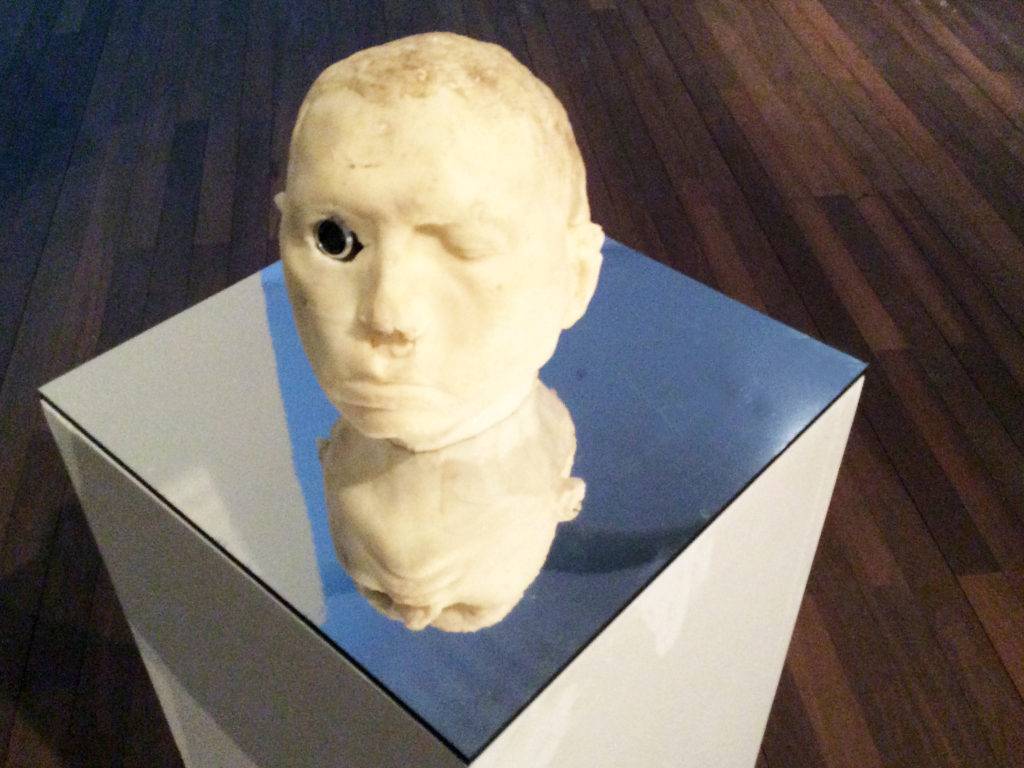
Image 4. One of the foam heads from Noxious Sector with video camera placed in on exhibit for use in the gaming space.
The aim of the space is similar to the goals of introducing games with alternative thematics and win strategies into the exhibition. The space encourages visitors to experiment, to play, and to deal with the emotions that are generated while playing and this as part of performative setting in which they as visitors are effortlessly transformed into taking on the role of the performer. For Asia, especially for Korea and Japan, this type of engagement encourages people to engage with their emotions and develop a sense of social interaction, which is absent or repressed due to the rigidity of the educational systems and work hierarchical work environments they are accustomed to. Such situations are considered as game-based learning models, where players learn to feel that they can be open about expressing themselves through their interactions to the people playing and those around them as spectators. The experience increases an appreciations for art as well as design, hones their social skills and and assures them of positive aspects of collaborative achievement, which has impact on both the individual and the group.
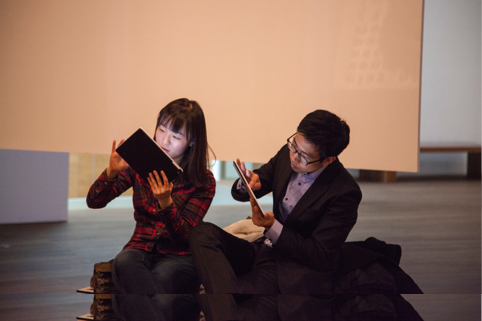
Image 5. Visitors sitting in the gaming space and interacting with the multiple player game “Drei” by Etter Studio & Mario Rickenbach (CHE)
It can be seed the rigidity is counter to true creative. Corporations are also very interested in how the element of play can be used to better the social skills of their employees and even increase a sense of cohesion within the company. In developing the art of gaming project, we have worked with a number of artists and came up with different scenerios. The groups had a lot of freedom and each of the proposals for the space were contrasting in their approach but all provided an experience suited to task set out by the project.
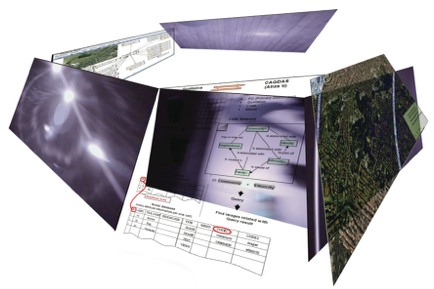
Image 6. Original layout of Game of Drones by Noxious Sector showing the information screen and video captures screens
Concept of a Games Space
As mentioned above, the main idea behind the Gaming Space was to create a unique atmosphere for playing games. Since the indie games on display offered more of an aesthetic experience than standard games might, it was important for the curators to provide to achieve an atmosphere that was inviting and reflected the alternative nature of the game designs themselves.
The approach to designing the space was inspired by the concept of the Pop Up Store, which is basically temporary space dedicated to flash retailing, selling merchandise of any kind ranging from art and design objects to tech gadgets and food and beverages. Pop Ups have been around since the 1990s and are emerged profusely in large urban cities such as Tokyo, London, Los Angeles and New York City. They offer an alternative to traditional brick-and-mortar and big-box stores and have ushered in the acceptance of short-term stores that are just about as creative as they are engaging.
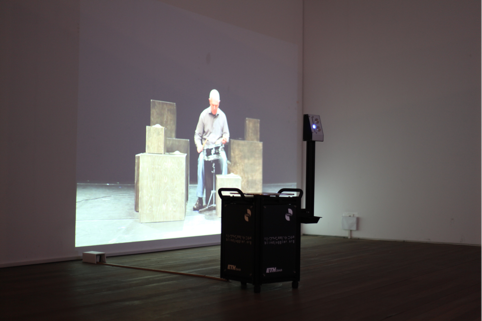
Image 7. The DAW “Blind Jugglers” project between Rafael D’Andrea and Fritz Hauser. The Blind Juggler Machine by A’ndrea is in the foreground and the Film featuring Fritz Hauser is in the back ground.
The use of the Pop Up space concept in a museum context allowed us to build the concept of alternative culture and to create an exciting and unusual experience, that contrasted with standard expectations of exhibition approaches in museums. The boundaries of the pop up spaced delineated the borders of a kind of play zone, in which visitors were invited to drop standard museum etiquette and to participate in more playful and emotionally engaging manner. It was a safe zone in which all were encourage to creatively “misbehave”.
Design Suggestions
There were two proposals for the space. One was by the Swiss arts group The Curious Minded and the other was by the Canadian arts collective Noxious Sector.
The proposal for the space by the Curious Minded was inspired by the urban design approach pioneered by FREITAG, a Swiss company who focused on making bag designs with down cycled materials. The proposal included custom designed lights which extended the urban feeling of FREITAG bags into the area of lighting, echoing and expanding the feeling of the everyday bringing a certain comfort through the element of the familiar. The proposal also included the idea of enclosing the installation with video screens in order to frame the space in, in order to provide a certain sense of retreat while also providing screens to be used with a more elaborate open screen gaming environment, which projected on to a four-sided screen setup. Other features if the proposal included podiums for sitting and display which were enhanced with Indie gamers quotes printed on reflective surfaces and a collection of iPad Covers that increased the awareness of the games and added a secondary display factor to the installation.
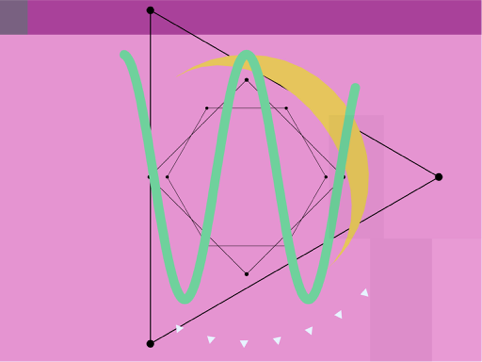
Image 8. A screen shot of Jono Brandel’s iPad game “Patatap”, a portable animation and sound kit that allows the user to create melodies charged with moving shapes by on classic motives form Kandinsky, Fisher, etc, with a touch of a finger,
The proposal by Noxious Sector was entitled “GAME OF DRONES”. The basis of the proposal was the creation of a simple game, which was in the form of a performance where teams were instructed to throw video cameras at each other as they ran around the city. The cameras were stuffed into foam replicas of the members of the group and were networked with GPS, so that thee trajectories drawn by the flight of the cameras during the game could be registered.
The video cameras capture all the activity and provide a visualisation of the game as it took place in Seoul. The taped results were used to form a multi-channel, video panorama installation in the museum on a series of four walls. The project utilises MaxMSP to integrate multiple video streams, including didactic information describing the “game” and the conceptual framework for the project. The game and it’s use of video cameras as drones is as much a metaphor for technological living as it is a playful way to engage the concept of militarised vision in a highly regulated social and political world.

Image 9. A screen shot from the iPad game “MIKMA” by Nadezda Suvorova, a mobile application based on the quest for light that lets the user explore scientific imaging from the infinitely small to the origins of the universe,
In the end, a both arts groups collaborated in the final design of the space and the best of both proposals was included into the space. The design for the inside of the space by the Curious Minded was implemented. In addition to the sitting and display podiums with quotes that defined such terms as “code”, “play”, “space”, and “game”, three podiums were added that displayed the foam head drones so that they could actually be used in the space. By throwing any one of the heads against a target provided on the back of one of four having screens that delineated the boundaries of the space, visitors could drastically effect the playback of the video documentation of the Game of Drones.
The outside section of the proposal from Noxious Sector was taken and a set of four hanging screens were used to define the space itself. On three of the screens, the video documentation that was created with the foam head drones was played back and on the fourth screen information was provided that mapped and tacked the performance activities that took place in Seoul for visitors to follow. Part of the screen was also dedicated to displaying the internal working of the software, in order to show visitors what actually happens when one of the heads hit the target.
A Word on Collaborations
The festival has always believed that in order to effectively market an artist or exhibition, art organisers must of course use the funding provided by national art councils to properly platform supported artists, but they must also go beyond this and use collaboration between artists of diverse origins as the main factor in creating effective partnerships that expand into future projects and events and provide return on the initial investments made.
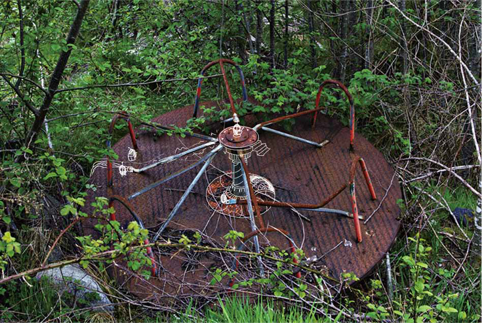
Image 10. A Screen shot of The Watcher, an iPad game by the Korean game group Turtle Cream. During the game play, the player only needs to watch the game without any intervention, playing with the urge to control the game but being punished if the player intervenes by having the game reset to the beginning.
The collaboration between the Swiss and Canadian art groups which brought about the Pop Up Space for gaming was an ideal example of such a collaboration. Both groups were able to realise their work by drawing on a larger team and funding base, and they were able to create a project that can be documented as an important international collaboration, which then is then reported back to the arts council as successful and rewarding both in terms of national representations and artistic presentation.
An additional collaboration that took place and which was part of the the art of gaming show was the DAW project with Raffaello D’Andrea and the from the ETH Zurich and the photographer and film maker Alessandro Frigerio. D;Andrea’s work on dynamic engineering is well known and celebrated academically. His Blind Juggler is a machine that can keep a ball bouncing on a paddle without any sensory input and because it can juggle balls without any sensory feedback, the machine could be considered to operate blind. The Cloverleaf Juggler that was on exhibit near the Pop Space features four separate concave areas that allow for the simultaneous juggling of 4 balls.
Picking up on the theme of blindness, the DAW produced a film with the Swiss percussionist Fritz Hauser that would play simultaneously while the Blind Juggler was in operations and visitors were using it to juggle one to four balls.
Hauser was given a set if instructions by DAW which defined and limited what he was to play. The patterns that he created were designed to interact in a musical manner with the Blind Juggler and appear to possess musical coherence despite that fact that there was no connection or coordination between the patterns played by Hauser in the film and the juggling patterns created by the machine. It was truly a study on controlled randomness and human perception that invited people to experiment to participate in the exhibitions as performers and not just as bystanders, reinforcing the main motivations for creating the gaming space in which people could shed the standard roles common to museum visit.
Selected Games
The selection of games presented divided into three categories. The first category of games was created by working closely with the game department at Geneva University of Art and Design (HEAD), who have been a leading force in inspiring the creation of indie games for the last five or so years. The games choose were selected because they embraced the theme of creativity and how it can be mediated using the hands on approach natural to game playing. Games by Nadezda Suvorova, Tobias Neukom, Etter Studio, Mario Rickenbach, Valentin Heun, Austin S. Lee, The Curious Minded, and
Fabien Duperrex were presented and made available to all visitors to play ad lib within the game space. Attendants were available to assist in explaining the games and how to download available games from the internet on to their now devices.
The second category of games where from the Korean game designers Turtle Cream and Jae Woo Jeon and Jong Wha Kim were included in the exhibition to provide contrast to the Swiss designers and to connect at the level of a cultural exchange program between designers form Switzerland and South Korea.
A third category was included to make not only a contrast between the games from Switzerland and Korea, but also to include a games that explore sounds, which could bot be found amongst the Swiss and Korean games and because they games were designed by more established game developers and could be used as a bench marking tool that helped convince visitors that the games provided by the Swiss designers were at an very professional level and compatible to professional such as Jono Brandel, Bastus Trump, Scott Snibbe, and Joshue Ott.
Conclusion
In conclusion, it must be stated that since the advent of digital culture, museum praxis has changed with it. By providing a separate space for gaming and modelling it after Pop Up Shop concepts, it was easy to integrate games and game playing into the context of a traditionally styled museum and at the same time make the aspect of actual play acceptable by both visitors and museum staff.
The atmosphere of the gaming space also allowed visitors to take more time because the felt secluded and shut off from the other parts of the exhibition. This let people explore most of the games while at the same time being able to come to an understanding of the difference between indie and commercial gaming approaches.
On the level of collaboration, having the space designed by two artists group as a project for other artists and one which would really explore the idea of play, lead to a high level of cultural exchange that will open up future possibilities for all involved.
Wether questions such as ”if gaming is an art form?” or wether “gaming can be used to transfer knowledge about creativity?” were actually answered, one can only state that the gaming space provided a platform that would let the visitor to the exhibit find answers to such questions by simply personally experiencing gaming in museum context and amongst “true” works of art.